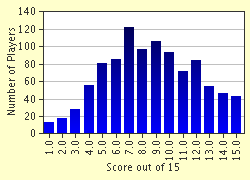Quiz Answer Key and Fun Facts
1. Founded in 1589, Tsaritsyn had seen its share of battles. The name was changed to Stalingrad by Josef Stalin to honour his personal contribution to the Russian civil war of 1918-21. In 1961, during the period of "de-Stalinization", Nikita Khrushchev gave the city yet another name, which it still has today. What name is it?
2. Ironically, the battle that turned the tide on Germany was not the initial objective. Two large German army groups were on route towards the Crimea and the Caucasus when Hitler ordered 6th army to take Stalingrad along the way. What was so important to Germany that he would send such a large force deep into Southern Russia?
3. When 6th Army closed in eastward towards Stalingrad, their first objective was to capture the west bank of a formidable river. Six months later the same river would act as a geographical boundary trapping them in the "kessel" around Stalingrad. What's the name of this river?
4. Capturing Stalingrad was of a fairly minor strategic importance, though it did have some military value with large armament factories. More importantly it would allow the Germans to halt activity on the Volga. What body of water does the Volga empty into?
5. Hitler's fractured confidence in General Kleist and a quarrel with Field Marshal von Rundstedt led to the shock appointment of Friedrich Wilhelm Paulus as commander-in-chief of the 6th Army. What was surprising about the appointment?
6. The defence of Stalingrad saw a new breed of Russian commander emerge - tactically adept and ruthless to the letter, as they needed to be to carry out Stalin's 'stavka' order. Three of the following generals were instrumental in keeping the defence going, another is fictitious. Who is the fictitious one?
7. The Luftwaffe started proceedings with a five-day assault on the city. 1,200 bombers, dropping incendiary bombs and mines, reduced Stalingrad to rubble and buried 50,000 civilians. The man giving the orders as commander of the 4th Air Fleet was cousin to a WWI fighting ace. Who was he?
8. After the artillery and bombing barrage, the ground forces and panzers moved in to begin the assault. The panzers were not very effective in this instance and were unable to effectively support the infantry. Why?
9. 100 meters high, this hill was the only significant high ground in the city. If the Germans held it they would have a good firing position across the Volga. For that reason the Russians would not let it go. It changed hands eight times in the fiercest contest of blood and loss of life yet seen in the war. What was the name of the hill?
10. A Russian sergeant and his platoon of 24 men held this four-storey apartment block for 59 days. Wave after wave of German infantry and panzer assaults were repelled under intense fire. It's an epic story of determination and desperation. The house remains today as a symbol of Russia's stubborn resistance. What name was given to the apartment?
11. A new cult of fighting, 'sniperism', emerged within the rubble. 'Fritz'-hunting became a popular, sadistic, socialistic competition. Vasily Zaitsev was indeed the most popular sniper, but was he credited with the most kills?
12. Due to Stalin's 'stavka' order, defections were a major ongoing concern for SMERSH units and the NKVD. However, they never fully appreciated the massive scale of those that crossed to the other side. The German word for these Russians was 'Hilfswillige,' meaning volunteer helpers. What was the common, shortened name?
13. After months of bitter fighting and with the winter freeze setting in, German generals wanted to withdraw and prepare defences. Hitler refused. Despite reports of an enemy build up on the Stalingrad flanks, Paulus did nothing to reinforce them. On November 19, Zhukov launched his trap and Russians soon ran through the thin flanks. Which German ally was responsible for defending the flanks?
14. By December, 300,000 Axis troops were cut off in Stalingrad and the surrounding "kessel". Hitler still refused to allow a breakout. His only concession was to allow an attempt to open a corridor to the stranded army from the west. Who orchestrated this ill-fated attempt?
15. Starved, covered in lice, frozen, exhausted and out of ammunition, Paulus surrendered his army on the 31st of January, 1943. The surviving Germans crawled out of cellars and bunkers and were marched of to captivity. Of the 300,000 men initially surrounded, how many were taken prisoner?
Source: Author
Bertho
This quiz was reviewed by FunTrivia editor
bloomsby before going online.
Any errors found in FunTrivia content are routinely corrected through our feedback system.

